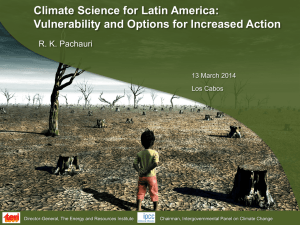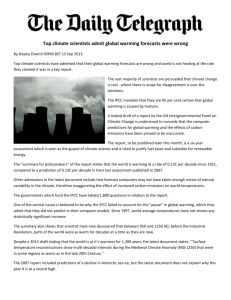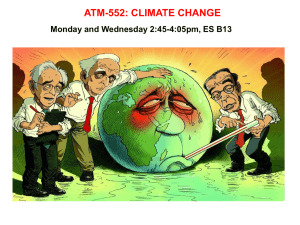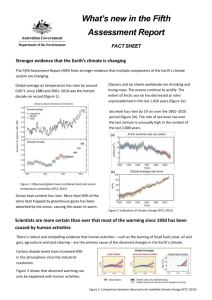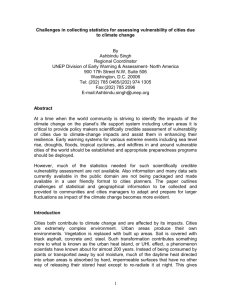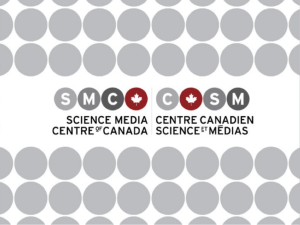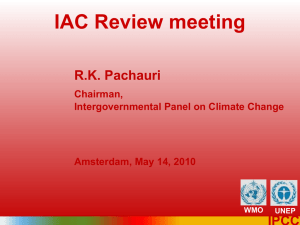Potential Research Topics - UW Program on Climate Change
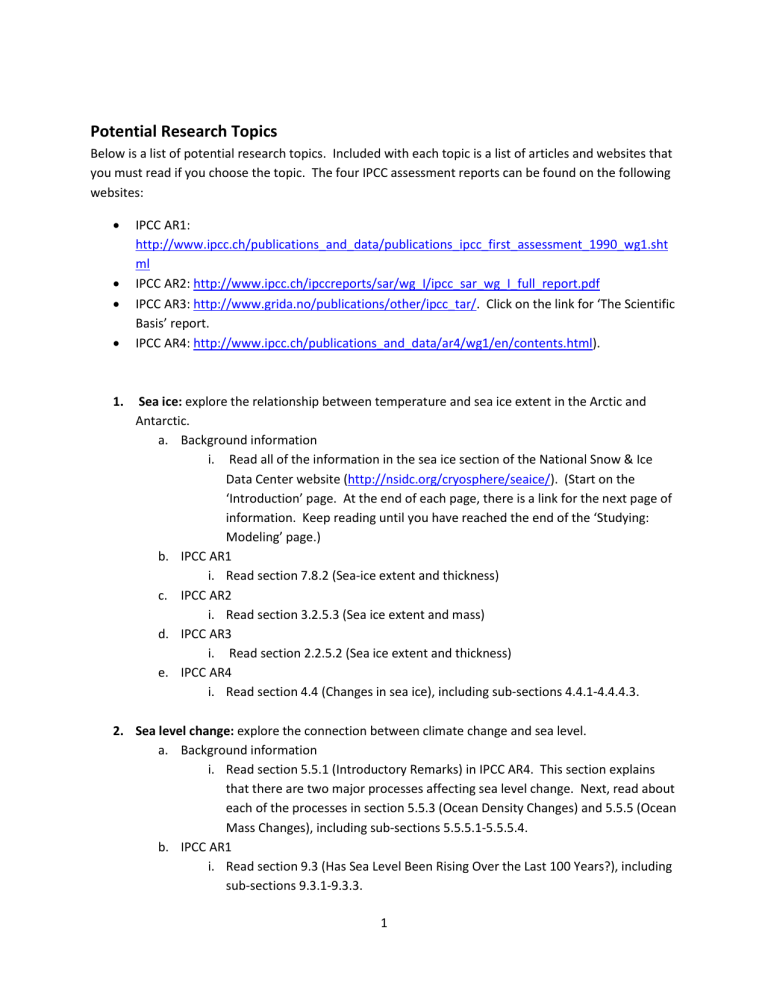
Potential Research Topics
Below is a list of potential research topics. Included with each topic is a list of articles and websites that you must read if you choose the topic. The four IPCC assessment reports can be found on the following websites:
IPCC AR1: http://www.ipcc.ch/publications_and_data/publications_ipcc_first_assessment_1990_wg1.sht
ml
IPCC AR2: http://www.ipcc.ch/ipccreports/sar/wg_I/ipcc_sar_wg_I_full_report.pdf
IPCC AR3: http://www.grida.no/publications/other/ipcc_tar/ . Click on the link for ‘The Scientific
Basis’ report.
IPCC AR4: http://www.ipcc.ch/publications_and_data/ar4/wg1/en/contents.html
).
1.
Sea ice: explore the relationship between temperature and sea ice extent in the Arctic and
Antarctic. a.
Background information i.
Read all of the information in the sea ice section of the National Snow & Ice
Data Center website ( http://nsidc.org/cryosphere/seaice/ ). (Start on the
‘Introduction’ page. At the end of each page, there is a link for the next page of information. Keep reading until you have reached the end of the ‘Studying:
Modeling’ page.) b.
IPCC AR1 i.
Read section 7.8.2 (Sea-ice extent and thickness) c.
IPCC AR2 i.
Read section 3.2.5.3 (Sea ice extent and mass) d.
IPCC AR3 i.
Read section 2.2.5.2 (Sea ice extent and thickness) e.
IPCC AR4 i.
Read section 4.4 (Changes in sea ice), including sub-sections 4.4.1-4.4.4.3.
2.
Sea level change: explore the connection between climate change and sea level. a.
Background information i.
Read section 5.5.1 (Introductory Remarks) in IPCC AR4. This section explains that there are two major processes affecting sea level change. Next, read about each of the processes in section 5.5.3 (Ocean Density Changes) and 5.5.5 (Ocean
Mass Changes), including sub-sections 5.5.5.1-5.5.5.4. b.
IPCC AR1 i.
Read section 9.3 (Has Sea Level Been Rising Over the Last 100 Years?), including sub-sections 9.3.1-9.3.3.
1
ii.
Read section 9.5 (How Might Sea Level Change in the Future?), including subsections 9.5.1-9.5.2. c.
IPCC AR2 i.
Read section 7.2 (How Has Sea Level Changed Over the Last 100 Years?), including sub-sections 7.2.1-7.2.2. ii.
Read section 7.5 (How Might Sea Level Change in the Future?), including subsections 7.5.1-7.5.5. d.
IPCC AR3 i.
Read section 11.3 (Past Sea Level Changes), including sub-sections 11.3.1-11.3.3. ii.
Read section 11.5 (Future Sea Level Changes), including sub-sections 11.5.1-
11.5.4.3. e.
IPCC AR4 i.
Read section 5.5.2 (Observations of Sea Level Changes), including sub-sections
5.5.2.1-5.5.2.6. ii.
Read section 5.5.6 (Total Budget of the Global Mean Sea Level Change). iii.
Read Frequently Asked Question 5.1 (Is Sea Level Rising?).
3.
Atmospheric carbon dioxide: explore the relationship between carbon dioxide and atmospheric temperature. a.
Background information i.
Read section 1.2 (Carbon Dioxide) in IPCC AR1, including sub-sections 1.2.1-
1.2.1.3. ii.
In IPCC AR4, read Frequently Asked Question 2.1, including Box 1: “What is
Radiative Forcing?” b.
IPCC AR1 i.
Read sub-sections 1.2.4.1-1.2.4.3 within section 1.2.4 (The Contemporary
Record of Carbon Dioxide- Observations and Interpretation). ii.
Read section 1.2.6 (Sensitivity Analyses for Future Carbon Dioxide
Concentrations). c.
IPCC AR2 i.
Read sub-sections 2.1.1-2.1.3.2 within section 2.1 (CO
2
and the Carbon Cycle). d.
IPCC AR3 i.
Read sub-sections 3.5.1-3.5.2 within section 3.5 (Observations, Trends and
Budgets). ii.
Read section 3.7.3.2 (Concentration projections based on IS92a, for comparison with previous studies). e.
IPCC AR4 i.
Read section 2.3.1 (Atmospheric Carbon Dioxide).
2
4.
Atmospheric methane: explore the relationship between methane and atmospheric temperature. a.
Background information i.
Read the NASA article, “Methane: A Scientific Journey from Obscurity to Climate
Super-Stardom”
( http://www.giss.nasa.gov/research/features/200409_methane/ ) ii.
In IPCC AR4, read Frequently Asked Question 2.1, including Box 1: “What is
Radiative Forcing?” b.
IPCC AR1 i.
Read section 1.3 (Methane), including sub-sections 1.3.1-1.3.5. c.
IPCC AR2 i.
Read section 2.2.2.1 (Methane). ii.
Read section 2.2.3.1 (The methane budget). d.
IPCC AR3 i.
Read section 4.2.1.1 (Methane). e.
IPCC AR4 i.
Read section 2.3.2 (Atmospheric Methane).
5.
Ocean heat content: explore the role that ocean heat content plays in changes to the Earth’s climate. a.
Background information i.
Read the NOAA article, “Climate Change: Ocean Heat Content”
( www.climatewatch.noaa.gov/article/2011/climate-change-ocean-heatcontent ). ii.
Read the NASA article, “Earth’s Big Heat Bucket”
( http://earthobservatory.nasa.gov/Features/HeatBucket/ ). Read all the pages
(1-5) of this article. b.
IPCC AR1 i.
Read section 7.7 (Sub-Surface Ocean Temperature and Salinity Variations). c.
IPCC AR2 i.
Read section 3.2.4 (Subsurface Ocean Temperatures). d.
IPCC AR3 i.
Read section 2.2.2.5 (Sub-surface ocean temperatures and salinities). e.
IPCC AR4 i.
Read section 5.2.2 (Ocean Heat Content), including sub-sections 5.2.2.1-5.2.2.3.
6.
Atmospheric aerosols: explore the relationship between aerosols and atmospheric temperature. a.
Background information i.
Read the NASA article, “Aerosols: Tiny Particles, Big Impact”
( http://earthobservatory.nasa.gov/Features/Aerosols/ ).
3
ii.
In IPCC AR4, read Frequently Asked Question 2.1, including Box 1: “What is
Radiative Forcing?” b.
IPCC AR1 i.
Read section 2.3.2 (Direct Aerosol Effects) ii.
Read section 2.3.3 (Indirect Aerosol Effects) c.
IPCC AR2 i.
Read section 2.3 (Aerosols), including sub-sections 2.3.1-2.3.4. d.
IPCC AR3 i.
Read section 5.1 (Introduction), including sub-sections 5.1.1-5.1.2. e.
IPCC AR4 i.
Read sub-sections 2.4.1-2.4.3 of section 2.4 (Aerosols).
7.
Glaciers: explore the relationship between temperature and glacial retreat. a.
Background information i.
Read the National Snow & Ice Data Center website
( http://nsidc.org/cryosphere/glaciers/ ). Focus on the information in the
‘Introduction’, ‘The Life of a Glacier’, ‘About Glaciers’ and ‘Photo Gallery’ sections of this website. (Start on the ‘Introduction’ page. At the end of each page, there is a link for the next page of information. Keep reading until you have reached the end of the ‘Drumlins’ page.) b.
IPCC AR1 i.
Read section 7.8.3 (Land Ice). c.
IPCC AR2 i.
Read section 3.2.5.1 (Retreat of glaciers). ii.
Read section 7.3.2 (Glaciers and Ice Caps), including sub-sections 7.3.2.1-7.3.2.3. d.
IPCC AR3 i.
Read section 2.2.5.4 (Mountain glaciers). e.
IPCC AR4 i.
Read section 4.5 (Changes in Glaciers and Ice Caps), including sub-sections 4.5.1-
4.5.3.
8.
Ocean salinity and circulation: explore the salinity of Earth’s oceans and how salinity changes can affect ocean circulation, especially in the Atlantic Ocean. a.
Background information i.
Read the NASA article, “Science: Ocean Circulation & Climate”
( http://aquarius.nasa.gov/science-ocean.html
). If you want, you can also watch the videos linked at the bottom of this article. ii.
Read pages 1-3 of the NOAA article, “The Global Conveyer Belt”
( http://oceanservice.noaa.gov/education/kits/currents/06conveyor.html
). b.
IPCC AR1 i.
Read section 7.7 (Sub-Surface Ocean Temperature and Salinity Variations). c.
IPCC AR2
4
i.
Read section 3.4.3 (Northern Hemisphere Circulation). When reading this section, just focus on the part that discusses the North Atlantic Oscillation
(NAO). d.
IPCC AR3 i.
Read section 7.3.7 (Thermohaline Circulation and Ocean Reorganisations). e.
IPCC AR4 i.
Read section 5.2.3 (Ocean Salinity). ii.
Read section 5.3.2 (Atlantic and Arctic Oceans). iii.
Read sub-section 5.3.2.1 (North Atlantic Subpolar Gyre, Labrador Sea and Nordic
Seas). iv.
Read Box 5.1 (Has the Meridional Overturning Circulation in the Atlantic
Changed?)
9.
Tropical cyclones: explore recent changes in the tropical cyclones (a category that includes hurricanes). a.
Background information i.
Read the NCAR article, “Hurricanes and Climate Change”
( www.cgd.ucar.edu/research/climate/hurricanes.html
). ii.
Read the NASA website, “Hurricanes: The Greatest Storms on Earth”
( http://earthobservatory.nasa.gov/Features/Hurricanes/hurricanes_3.php
).
Read just the “Hurricane Climatology” portion of this website. b.
IPCC AR1 i.
Read section 7.11.3 (Tropical Cyclones). c.
IPCC AR2 i.
Read section 3.5.3.1 (Tropical cyclones). d.
IPCC AR3 i.
Read section 2.7.3.1 (Tropical cyclones). e.
IPCC AR4 i.
Read section 3.8.3 (Evidence for Changes in Tropical Storms), including subsections 3.8.3.1-3.8.3.6. ii.
Read Box 3.5 (Tropical Cyclones and Changes in Climate).
10.
Extreme temperature and precipitation events: explore changes in temperature and precipitation in recent years. a.
Background information i.
Read section 3.8.1 (Background) of the IPCC AR4. b.
IPCC AR1 i.
Read section 7.11.2 (Droughts and Floods). c.
IPCC AR2 i.
Read sub-sections 3.5.2.1-3.5.2.2 in section 3.5.2 (Climate Variability). d.
IPCC AR3
5
i.
Read sub-sections 2.7.2.1-2.7.2.1 in section 2.7.2 (Is There Evidence for Changes in Variability or Extremes?) e.
IPCC AR4 i.
Read section 3.8.2 (Evidence for Changes in Variability or Extremes), including sub-sections 3.8.2.1-3.8.2.2. ii.
Read Frequently Asked Question 3.3 (Has there been a Change in Extreme
Events like Heat Waves, Drought, Floods and Hurricanes?)
11.
Oceanic dissolved carbon: explore the connection between anthropogenic carbon emissions and oceanic dissolved carbon. a.
Background information i.
Read section 1.2 (Carbon Dioxide) in the IPCC AR1, including sub-sections 1.2.1-
1.2.1.3. ii.
Read the NASA article, “Climate Change Seeps into the Sea”
( www.nasa.gov/topics/earth/features/climate_acidocean_prt.htm
). b.
IPCC AR1 i.
Read sub-sections 1.2.4.2 (Uptake by the ocean). c.
IPCC AR2 i.
Read sub-sections 2.1.4-2.1.5 within section 2.1 (CO
2
and the Carbon Cycle). d.
IPCC AR3 i.
Read section 3.2.3 (Ocean Carbon Processes), including sub-sections 3.2.3.1-
3.2.3.3. e.
IPCC AR4 i.
Read section 5.4.2 (Carbon), including sub-sections 5.4.2.1-5.4.2.4.
6
